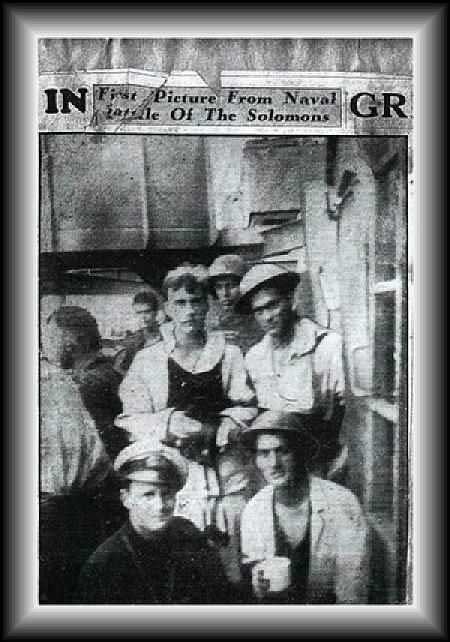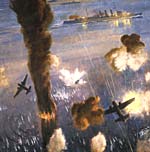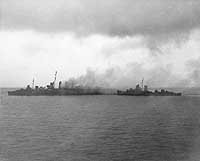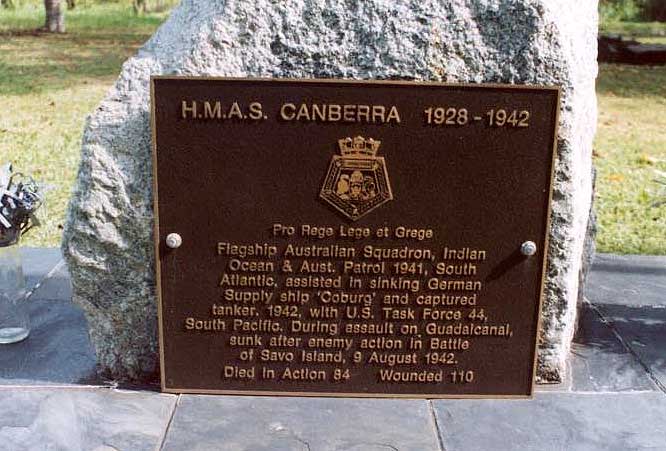|
Remembering HMAS Canberra 1, sunk at The Battle of Savo Island, 9th. of August 1942
Navy Week Service at the Shrine of Remembrance, Mr President, Captain Williams, Members of the RAN and Australian Naval Cadets, Ladies and Gentlemen, Shipmates. Thank you Mr President for your welcome. August 9th. 2008 was the 66th.anniversary of the Battle of Savo Island when an Allied Naval force was decimated by the Imperial Japanese Navy in the Solomon Islands.
In 1942, this area in the Pacific Ocean was a backwater, and very little was known about the Solomon Islands. Martin Clemens was a District Officer and Coast Watcher on the Island of Guadalcanal. On July 1st. in 1942, one of his police constables came rushing up to report:
The Japanese commenced to build an airfield on Guadalcanal, this would pose a threat to the vital shipping link between the US and Australia, used to ferry supplies of men and material to our country, set up as a base from which we might move northwards against the Japanese invaders in the Pacific. Clemens radiod the news off to his Coast Watcher boss, Eric Feldt in Australia, and that intelligence was quickly passed on to Washington DC. Admiral Ernest King, the Chief of Naval Operations there, decided that "Operation Watch Tower" the impending operation to land Marines on Guadalcanal and Tulagi, would be an all Naval affair, with Marines as the assault troops. General Douglas MacArthur with his South West Pacific Command that embraced the Solomons, wanted it to be an Army show with him in command. King quickly moved his command westwards, this now excluded the Solomons and ensured that MacArthur could not meddle in this proposed operation. It would be the first Allied offensive planned against the Japanese in the Pacific. Dog Day was set for August 7th. Vice Admiral Jack Fletcher USN. was made Commander of the Expeditionary Force, he had 3 carriers with a supporting Battleship, cruisers and destroyers. Rear Admiral Kelly Turner USN was in charge of the landing group of 15 transports for Guadalcanal, plus 4 transports and 4 destroyer transports destined for the Tulagi landing. Major General A.A.Vandegrift had command of the 1st. Marine Division. The Naval support group of six 8 inch cruisers, included HMA cruisers Australia and Canberra ( I had joined the latter in December 1941 as a Sub Lieutenant ) and two 6 inch cruisers including HMAS Hobart, plus eight Fleet destroyers, and was commanded by Rear Admiral V.A.C. Crutchley, VC, RN. ( he had won his VC in WW1 as a young Lieutenant ) Japanese Naval ships. 7th. of August 1842. On Guadalcanal, Marines quickly advanced as the Japanese took to the hills, on Tulagi it was a very different story, the Japanese could not withdraw, they stayed put, to slug it out with the invaders, it took two days to subdue their resistance. I could not believe the intense AntiAircraft fire that these planes could fly through and still survive, to drop their deadly torpedoes. Japanese air attacks on the invading force ships were pressed home, 16 enemy aircraft were destroyed, and we lost 12 carrier planes. Australia under air attack, August 8, 1942.
Mikawa. Night of the 7th./8th. of August 1942. Saturday the 8th. of August. An RAAF Hudson aircraft under the command of Sergeant Stan Stutt, flying a patrol from Milne Bay sighted Mikawa's fleet. He tried to transmit an enemy report, but could not raise his base ( it so happened that Milne Bay was under an enemy air attack and the radio station was shut down ) Stutt flew the long way home to report the sighting of 3 cruisers, 2 destroyers, and 2 Seaplane Tenders, this miss reporting of Seaplane Tenders led the Naval command of Guadalcanal to decide that this Japanese force was bound for Rekata Bay on St Isobel Island, to set up a seaplane base there. It was considered that enemy Submarines posed the main threat, and not surface ships. Night of the 8th./9th.of August 1942. US cruisers Quincy, Astoria and Vincennes with two destroyers carried out a box patrol to seal off the northern entrance, Blue and Ralph Talbot were again on watch seaward of Savo. Fletcher had decided to withdraw his Carrier support, citing that fuel was runing low as his reason, an absolute nonsense. Prior to the invasion he had promised to cover the landings with air support over a three day period, now he was off after but two days cover. This was to leave the Marines onshore, the troopships still unloading supplies and heavy equipment, and the support group bereft of any air support, naked to hard pressed enemy air attacks. A total disaster. Turner now called Crutchley and Vandegrift to his flagship Mc Cauley, anchored off Lunga Point, to discuss the position we were now left in. I have never forgiven Vice Admiral Jack Fletcher for deserting the landings at Guadalcanal and Tulagi. He was subsequently relieved of his command, and never again given a command at sea. Australia was now pulled out of her patrol role to transport Admiral Crutchley the 20 miles to reach Mc Cauley. Chicago's CO, Captain Howard Bode USN was senior ship, but he decided he would stay 600 yards astern of Canberra and lead from the rear. Middle Watch. Mikawa was now leading had no trouble in sighting the US they sighted both Blue and Ralph Talbot, reduced speed to sail past unseen, the Japanese also sighted the US destroyer Jervis, previously damaged but on her way alone to Australia for repairs, again no sighting of the enemy by the Americans. Their lookouts all fast asleep! It is quite unbelieveable, that all three US destroyers had 7 Japanese ships pass so close to them but remained undected either visually or by Radar. The Japanese lookouts in their ships in sighting the US destroyers. Mikawa sighed in relief and pressed on, the gate was open, he sailed his pack of dingoes straight through, on towards the flock of unsuspecting sheep. At 1:43 AM. several incidents crowded in, I was conscious of the time, I had to call the Navigator at 1.45 AM. so he might fix our position prior to the next 180 degree turn at 2 o'clock. There was an explosion almost due north, probably a Japanese torpedo blowing up at the end of its run, the Captain was called. The port lookout reported a ship ahead, but neither the Principal Control Officer, the Yeoman of Signals or myself, could make out anything. Patterson, our port escort destroyer signalled us using a small blinker tube, she had broadcast by Talk Between Ships telephone:
Although it is hard to believe and accept, Canberra was not fitted with TBS, and thus could not receive this warning, to go into battle with Allied ships and not to be able to communicate via TBS, is unforgiveable. We went to action stations, and I called the Gunnery Officer and the Navigator to the bridge. Torpedo tracks passed down our starboard side, the Navigator indicated " He had the ship" meaning I was relieved of the responsibility for the safe navigation of the ship. More torpedoes crossed our bows, starshell lit the scene, and Japanese ship floatplanes dropped flares on our starboard site, silhouetting us nicely for the Japanese attacking cruisers on our port side. I hastened to my action station in the fore control, overlooking the bridge, here as Rate Officer, my task was to estimate the course and speed of enemy ships. Using my binoculars I saw a Mogami Class cruiser with her large trunked funnel, only about 3,000 yards away, blasting away at us with her 8 inch armament, I recall saying:" My God! this is bloody awful." and it was. We were hit amidships, the Walrus aircraft blazing fiercely on its catapult. A shell exploded on the port side of the compass platform decapitating Lieutenant Commander Hole our Gunnery Officer, and mortally wounding Captain Getting, plus wounding bridge officers. Another shell burst just aft of the fore control, and the plotting office was wiped out, this prevented our enemy report and warning to the Northern group from being transmitted. I had been virtually surrounded by incoming shells but has escaped unscathed. The ship soon lost power, stopped, taking on a list to starboard, for my ship, the war was over, only 2/3 minutes had passed since we went to action stations. Post war, research found we picked up a torpedo between both boiler rooms, that had emanated from our starboard escort destroyer USS Bagley, friendly fire we could have done without. The Japanese force now split into two columns, sank all three US cruisers of the northern group, and then withdrew northwards. Patterson to the rescue. Patterson was also loading our badly wounded. including Captain Getting, still alive, but only just, he died the next day. An hour later a cruiser loomed up astern and started shooting at us, it happened to be Chicago ( using my binoculars, I had identified her ) she had mistaken us to be a burning enemy ship. Patterson cut all lines, and took off to sort out this latest mess, I remember the cheery words of her Captain, Commander Frank Walker,
Captain Bode (Chicago's CO) was later criticised for his actions in Chicago at Savo, and he later committed suicide. Daylight at last dawned.
The two destroyers took us to the US Transports Fuller and Barnett, off to Noumea where we all boarded President Grant for eventual passage home to Sydney. I was summoned to attend a Board of Enquiry as to Canberra's loss, then two weeks leave to rekit, and off to sea once more as a watchkeeper in the old light cruiser HMAS Adelaide. Losses. It was the worst US Navy blue water defeat to date. Memorial on Guadalcanal. The Rudd Government provided funds to replace it, and only last August a new memorial with a suitable plaque was unveiled and dedicated at a new site in gardens close to the Honiara Police Station. ( a much more suitable site than the earlier one ). Some of Canberra's survivors made the journey to be present at that ceremony.
Thank you all for remembering with me, and also for your attention. |




